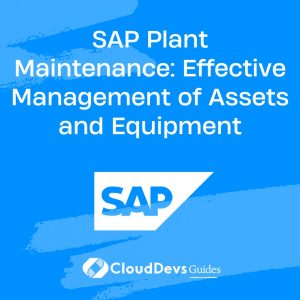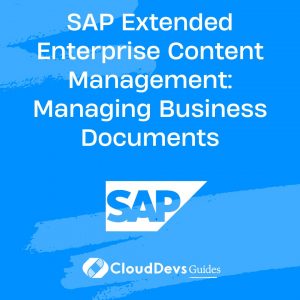SAP Plant Maintenance: Effective Management of Assets and Equipment
In today’s highly competitive business landscape, the effective management of assets and equipment is crucial for any organization aiming to thrive and stay ahead of the curve. One of the powerful tools in this endeavor is SAP Plant Maintenance, a comprehensive solution that helps companies maintain, repair, and optimize their physical assets. In this blog, we will explore the key features and benefits of SAP Plant Maintenance, along with real-world examples and code samples to illustrate its effectiveness.
1. Understanding SAP Plant Maintenance
1.1. What is SAP Plant Maintenance?
SAP Plant Maintenance, often abbreviated as SAP PM, is an integral part of SAP’s Enterprise Resource Planning (ERP) suite. It is designed to facilitate the efficient management of an organization’s assets, including machinery, vehicles, buildings, and more. With SAP PM, businesses can plan and execute maintenance activities, track asset performance, and ensure compliance with safety and regulatory standards.
1.2. Key Features of SAP Plant Maintenance
- Asset Management: SAP PM provides a centralized repository for all asset-related information. This includes detailed records of equipment, maintenance schedules, and historical data. This feature enables organizations to make informed decisions about asset maintenance and replacement.
abap
DATA: lv_equipment_id TYPE equnr,
lv_equipment_desc TYPE eqktx,
lv_install_date TYPE idate.
SELECT SINGLE equnr
eqktx
idate
INTO (lv_equipment_id, lv_equipment_desc, lv_install_date)
FROM eqst
WHERE equnr = '10001'.
- Maintenance Planning: Efficient maintenance planning is vital to minimize downtime and reduce operational costs. SAP PM allows users to create maintenance plans and schedules, ensuring that assets receive timely attention.
abap
DATA: lv_maintenance_plan TYPE maintenance_plan,
lv_schedule_date TYPE sdate,
lv_work_order TYPE work_order.
SELECT SINGLE maintenance_plan
sdate
work_order
INTO (lv_maintenance_plan, lv_schedule_date, lv_work_order)
FROM maintenance_schedule
WHERE equipment_id = '10001'.
- Work Order Management: Work orders are essential for executing maintenance tasks. SAP PM streamlines the creation and management of work orders, making it easier to assign tasks, allocate resources, and monitor progress.
abap
DATA: lv_work_order_id TYPE wo_id,
lv_description TYPE wo_description,
lv_assigned_to TYPE wo_assignee.
SELECT SINGLE wo_id
wo_description
wo_assignee
INTO (lv_work_order_id, lv_description, lv_assigned_to)
FROM work_order
WHERE equipment_id = '10001'.
- Spare Parts Inventory: Keeping track of spare parts is crucial for maintenance operations. SAP PM includes features to manage spare parts inventory, ensuring that the right parts are available when needed.
abap
DATA: lv_part_number TYPE part_number,
lv_part_description TYPE part_description,
lv_quantity_in_stock TYPE quantity.
SELECT SINGLE part_number
part_description
quantity
INTO (lv_part_number, lv_part_description, lv_quantity_in_stock)
FROM spare_parts
WHERE equipment_id = '10001'.
- Reporting and Analytics: SAP PM provides robust reporting and analytics tools. Users can generate performance reports, analyze maintenance trends, and make data-driven decisions to optimize asset management.
abap
DATA: lv_maintenance_cost TYPE currency,
lv_downtime_hours TYPE hours,
lv_mtbf TYPE hours.
SELECT SUM(cost) AS maintenance_cost,
SUM(downtime) AS downtime_hours,
AVG(mtbf) AS mtbf
INTO (lv_maintenance_cost, lv_downtime_hours, lv_mtbf)
FROM maintenance_history
WHERE equipment_id = '10001'.
2. Benefits of SAP Plant Maintenance
Implementing SAP Plant Maintenance offers a wide range of benefits for organizations across various industries:
2.1. Increased Asset Reliability
By proactively managing maintenance and having access to historical asset data, organizations can increase the reliability of their assets. This leads to reduced downtime and higher productivity.
2.2. Cost Savings
Efficient maintenance planning and spare parts management lead to cost savings. Organizations can avoid unnecessary downtime and reduce the need for emergency repairs, ultimately saving money.
2.3. Improved Regulatory Compliance
SAP PM helps organizations adhere to regulatory standards and safety requirements. This is particularly crucial in industries with stringent compliance regulations, such as healthcare and aviation.
2.4. Enhanced Productivity
With streamlined maintenance processes and work order management, employees can work more efficiently. Tasks are assigned and completed with greater speed and accuracy.
2.5. Better Decision-Making
Access to comprehensive data and analytics allows organizations to make informed decisions about asset maintenance, replacement, and optimization.
3. Real-World Use Cases
Use Case 1: Manufacturing Industry
In the manufacturing industry, downtime can be extremely costly. Let’s look at how a manufacturing company uses SAP Plant Maintenance to minimize downtime and improve asset performance.
Challenge:
The company was experiencing frequent breakdowns of a critical production machine, resulting in production delays and increased maintenance costs.
Solution:
They implemented SAP PM to create a preventive maintenance plan for the machine. Using historical data, they scheduled regular maintenance activities, including inspections and parts replacements.
abap
DATA: lv_preventive_maintenance_plan TYPE pm_plan,
lv_inspection_schedule TYPE inspection_schedule,
lv_parts_replacement_schedule TYPE parts_replacement_schedule.
SELECT pm_plan
inspection_schedule
parts_replacement_schedule
INTO (lv_preventive_maintenance_plan, lv_inspection_schedule, lv_parts_replacement_schedule)
FROM machine_maintenance_plan
WHERE machine_id = 'M001'.
Result:
The company saw a significant reduction in machine breakdowns and downtime. Production efficiency improved, and maintenance costs decreased due to fewer emergency repairs.
Use Case 2: Utilities Industry
In the utilities industry, ensuring the reliability of equipment is paramount. Here’s how a water treatment plant uses SAP PM to maintain its equipment.
Challenge:
The water treatment plant had difficulty tracking the maintenance needs of its pumps, which are critical for water purification.
Solution:
They implemented SAP PM to create maintenance plans for each pump. These plans included regular inspections, lubrication, and parts replacement schedules.
abap
DATA: lv_maintenance_plan_pump1 TYPE maintenance_plan,
lv_inspection_schedule_pump1 TYPE inspection_schedule,
lv_lubrication_schedule_pump1 TYPE lubrication_schedule,
lv_parts_replacement_schedule_pump1 TYPE parts_replacement_schedule.
SELECT maintenance_plan
inspection_schedule
lubrication_schedule
parts_replacement_schedule
INTO (lv_maintenance_plan_pump1, lv_inspection_schedule_pump1, lv_lubrication_schedule_pump1, lv_parts_replacement_schedule_pump1)
FROM pump_maintenance_plan
WHERE pump_id = 'P001'.
Result:
The water treatment plant experienced fewer pump failures, ensuring a continuous supply of clean water to the community. Maintenance costs were controlled, and the plant met regulatory standards.
4. Implementing SAP Plant Maintenance
Implementing SAP Plant Maintenance requires careful planning and consideration. Here are the key steps involved:
4.1. Define Maintenance Objectives
Clearly define your organization’s maintenance objectives. What are you trying to achieve with SAP PM? Understanding your goals is essential for a successful implementation.
4.2. Data Migration
Ensure that your existing asset and maintenance data is accurate and up-to-date. You will need to migrate this data into SAP PM.
4.3. Configuration
Configure SAP PM to align with your organization’s specific needs. This includes setting up asset hierarchies, maintenance plans, work order types, and user roles.
4.4. Training
Train your staff on how to use SAP PM effectively. This includes both end-users and administrators who will manage the system.
4.5. Testing
Thoroughly test the system to ensure that it meets your requirements. Identify and address any issues before going live.
4.6. Go-Live
Once testing is successful, implement SAP PM in your organization. Monitor its performance and address any issues that arise during the initial rollout.
4.7. Continuous Improvement
Regularly evaluate the performance of SAP PM and look for opportunities to improve maintenance processes further.
5. SAP Plant Maintenance in Action
Let’s take a closer look at how SAP Plant Maintenance can be used to streamline the maintenance of a specific piece of equipment, such as a conveyor belt.
Scenario:
A manufacturing company relies on a conveyor belt system to transport materials within their facility. Regular maintenance is essential to prevent disruptions in production.
Step 1: Asset Registration
abap
DATA: lv_conveyor_belt_id TYPE equnr,
lv_conveyor_belt_desc TYPE eqktx.
SELECT SINGLE equnr
eqktx
INTO (lv_conveyor_belt_id, lv_conveyor_belt_desc)
FROM eqst
WHERE equnr = 'CB001'.
Step 2: Maintenance Planning
abap
DATA: lv_maintenance_plan_cb TYPE maintenance_plan,
lv_inspection_schedule_cb TYPE inspection_schedule,
lv_lubrication_schedule_cb TYPE lubrication_schedule,
lv_parts_replacement_schedule_cb TYPE parts_replacement_schedule.
SELECT SINGLE maintenance_plan
inspection_schedule
lubrication_schedule
parts_replacement_schedule
INTO (lv_maintenance_plan_cb, lv_inspection_schedule_cb, lv_lubrication_schedule_cb, lv_parts_replacement_schedule_cb)
FROM conveyor_belt_maintenance_plan
WHERE conveyor_belt_id = 'CB001'.
Step 3: Work Order Management
abap
DATA: lv_work_order_id_cb TYPE wo_id,
lv_description_cb TYPE wo_description,
lv_assigned_to_cb TYPE wo_assignee.
SELECT SINGLE wo_id
wo_description
wo_assignee
INTO (lv_work_order_id_cb, lv_description_cb, lv_assigned_to_cb)
FROM work_order
WHERE equipment_id = 'CB001'.
Step 4: Reporting and Analytics
abap
DATA: lv_maintenance_cost_cb TYPE currency,
lv_downtime_hours_cb TYPE hours,
lv_mtbf_cb TYPE hours.
SELECT SUM(cost) AS maintenance_cost,
SUM(downtime) AS downtime_hours,
AVG(mtbf) AS mtbf
INTO (lv_maintenance_cost_cb, lv_downtime_hours_cb, lv_mtbf_cb)
FROM maintenance_history
WHERE equipment_id = 'CB001'.
By following these steps and utilizing SAP Plant Maintenance, the manufacturing company can ensure the conveyor belt operates at optimal efficiency, reducing downtime and maintenance costs.
Conclusion
In today’s fast-paced business environment, effective asset and equipment management are essential for maintaining competitiveness. SAP Plant Maintenance empowers organizations to proactively manage their assets, reduce downtime, lower maintenance costs, and make data-driven decisions. By implementing SAP PM and following best practices, organizations can streamline their maintenance processes and achieve a higher level of operational efficiency. Whether you’re in manufacturing, utilities, or any other industry, SAP Plant Maintenance can be a game-changer in asset management.
Start your journey toward more efficient asset management with SAP Plant Maintenance today and experience the benefits it brings to your organization’s bottom line.
Table of Contents









